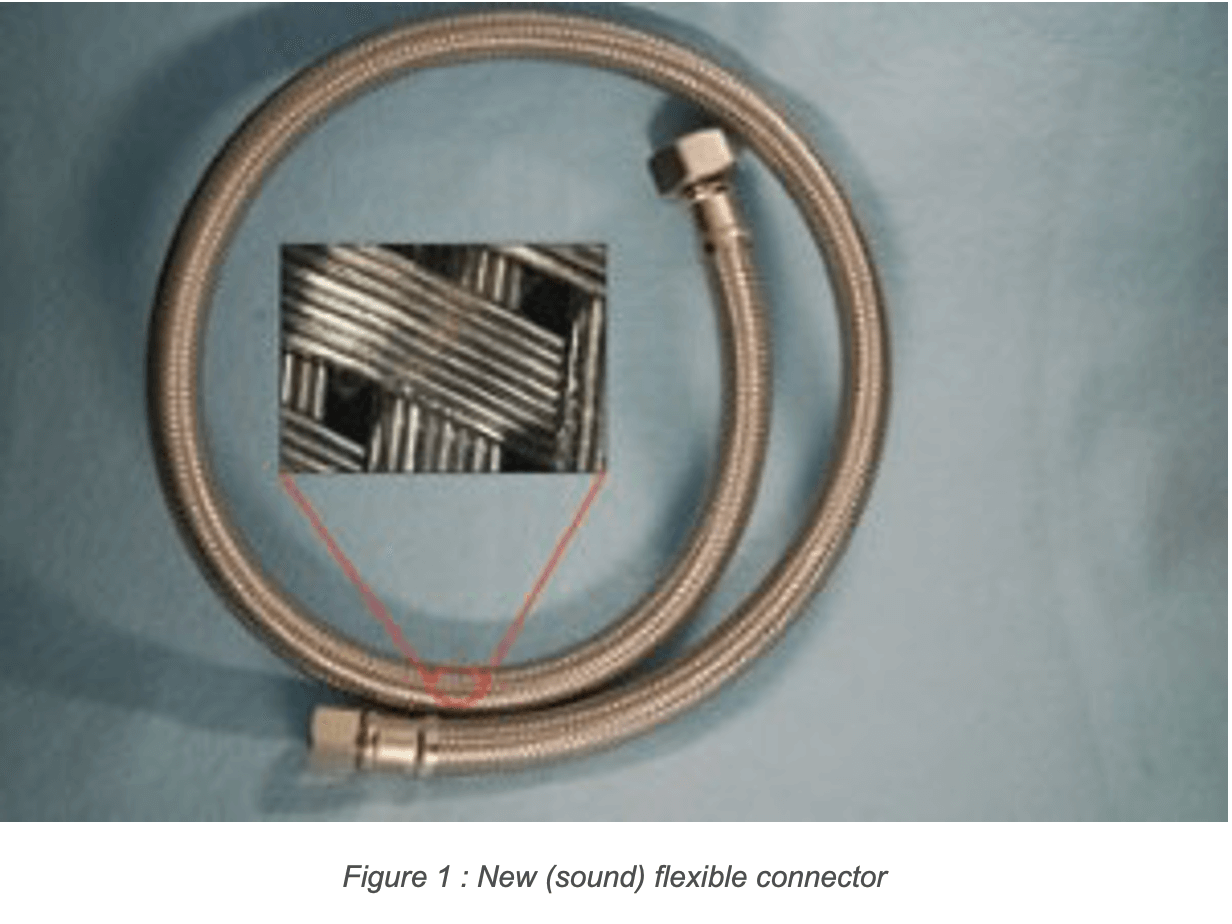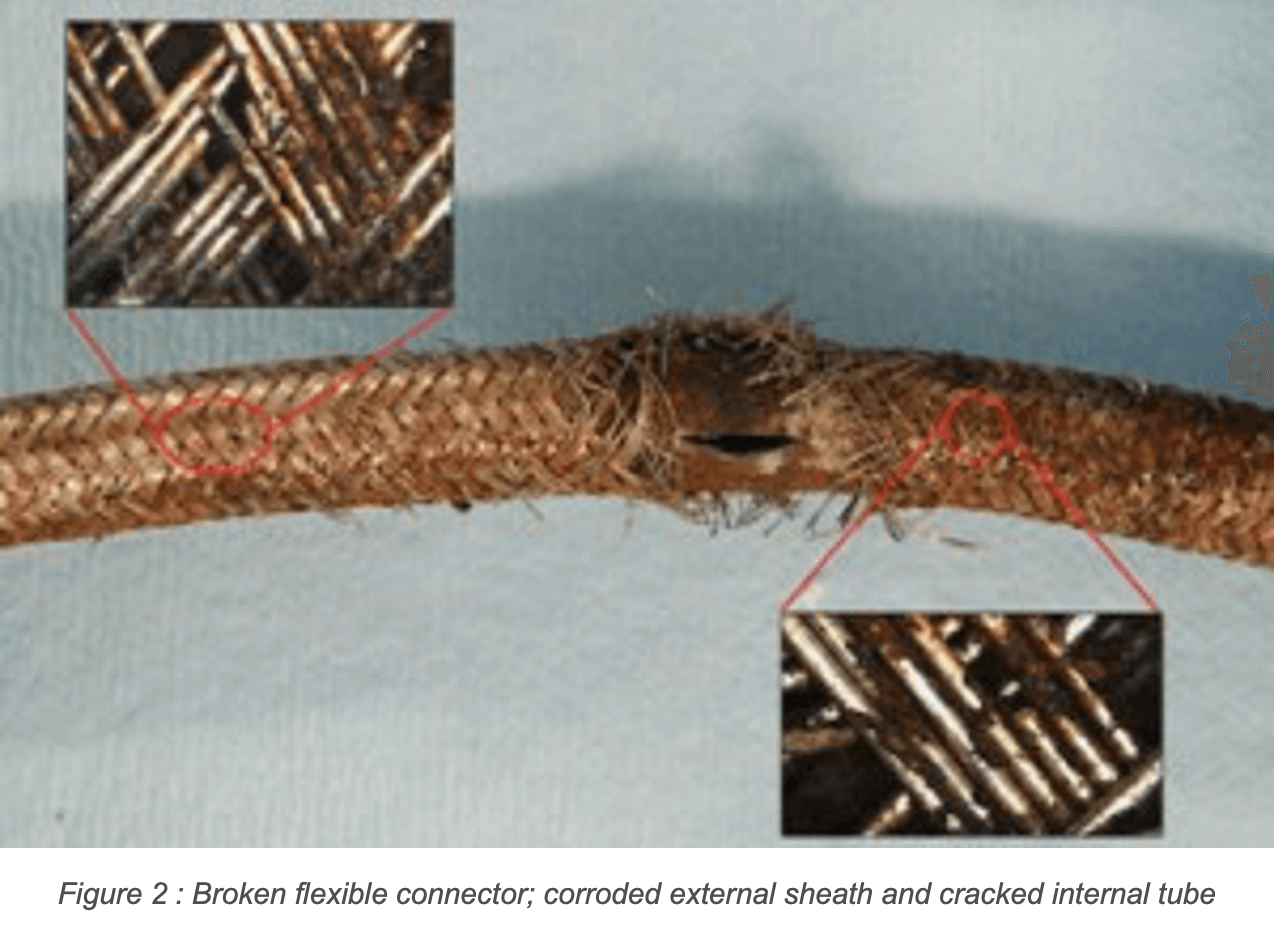Stainless steel made parts have revolutionized the industrial era due to their stability in various environments. The stability of this material is explained by the presence of a protective layer (commonly known as “passive layer”) which is formed naturally on the surface of stainless steel components. Stainless steel was created by adding, amongst other components, a minimal chrome concentration of 14% to “regular” steel (carbon steel). However, stainless steel made parts are not necessarily corrosion proof. This technical brief is the first of a series of three that will discuss the use of different stainless steel components found, among other things, in the majority of households.
Part 1: Sheath for Flexible Piping
Traditionally, plumbing components in buildings were mainly made of copper. Then, the industrial revolution brought on less costly materials, such as polymers and brass, that were also able to meet the typical service conditions in aqueous residential use. However, polymers exhibit limited mechanical properties. Therefore, reinforcement with metal components is required for their use. Subsequently, plumbing systems consisting of polymer piping and metal connections or flexible plastic piping covered by a stainless steel sheath (flexible connectors) were developed and are now commonly used. The latter type of plumbing system is discussed in this technical brief.
If you examine your dishwasher, faucets or toilets connections, you will realize that these flexible connectors, commonly known as  “speedway”, are frequently used in households. This type of connectors includes an external stainless steel sheath in order to meet the mechanical requirements while providing flexibility to the system/ assembly in order to facilitate its installation (figure 1).
“speedway”, are frequently used in households. This type of connectors includes an external stainless steel sheath in order to meet the mechanical requirements while providing flexibility to the system/ assembly in order to facilitate its installation (figure 1).
While stainless steel sheaths insure excellent mechanical properties to resist to the internal constraints produced by the water pressure and the deformations associated with the installation process, as well as a good resistance to mechanical damage, this material has a notorious limitation: it can easily corrode in the presence of specific constituents, thus resulting in its degradation. More precisely, chlorides and sulfur, amongst other corrosive species, have been identified to have the potential to cause rapid corrosion of stainless steel. But how does this phenomenon occur?
Flexible piping is typically installed in enclosed, confined locations, such as sink cabinets or cupboards. Theses locations are also often used to store cleaning products or other products that might contain chlorides and/or sulfur. Containers for these products do not necessarily prevent evaporation. As a result, stainless steel sheath of flexible connectors can be damaged by corrosion due to exposure to these components.
Chlorides and sulfur, in the presence of water (due to condensation or humidity), have the potential to locally destroy the protective layer on stainless steel. Once this layer has been perforated, the metal is exposed and a stainless steel part without passive layer becomes extremely subject to corrosion, as per the behavior of “regular” steel. The damaged regions become areas of weakness where the metal will preferentially corrode (by pitting corrosion). As a result, the strands forming the stainless steel sheath will rapidly break and fail due to their small diameters. Once a sufficient number of strands have failed, water pressure inside the plastic piping will lead to its perforation because the stainless steel sheath cannot play its reinforcing role anymore.
In order to determine if this phenomenon is responsible for the failure of a speedway, it is necessary to perform a metallurgical examination.  A macroscopic and high magnification analysis of the strands will allow to determine if characteristics associated with pitting corrosion, such as localized depressions of the sheath strands accompanied by corrosion deposits, are present on the subject piping (figure 2). Furthermore, surface analysis can reveal the nature of the components present in the corroded areas. The metallurgical examination could also show that the sheath had a manufacturing defect, or that mechanical damage (generated by a tool) was the cause of failure of the flexible connection.
A macroscopic and high magnification analysis of the strands will allow to determine if characteristics associated with pitting corrosion, such as localized depressions of the sheath strands accompanied by corrosion deposits, are present on the subject piping (figure 2). Furthermore, surface analysis can reveal the nature of the components present in the corroded areas. The metallurgical examination could also show that the sheath had a manufacturing defect, or that mechanical damage (generated by a tool) was the cause of failure of the flexible connection.
In conclusion, stainless steel is a high-performance material, but it can easily become vulnerable when subjected to certain conditions. In the specific case of flexible connectors (speedway) sheaths, chlorides and sulfur are corrosive elements that can rapidly affect stainless steel made parts integrity. Nevertheless, manufacturing defects, as well as mechanical damage (by tools), must also be considered as possible causes for the failure of the stainless steel sheath.
For more information or to talk about a claim with one of our experts, contact our Materials & Metallurgical Team at 877 686-0240 or info@cep-experts.ca.
